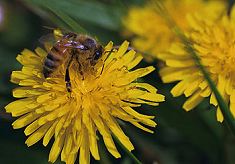Spring Tonics
By: Jessica Godino, Red Moon Herbs

Spring has finally arrived, and you are enjoying a lovely walk along the creek. Suddenly, something stings your ankle! No, its not a wasp, its the stinging nettle plant, known to botanists as Urtica dioica. But before you curse this common weed, you should know that it is one of the most nutrient dense foods available. Nettle greens are a rich source of calcium, magnesium, zinc, iron, cobalt, copper, potassium, trace minerals, chlorophyll, the B-complex vitamins, and more.
Not only are the greens incredibly good for you, they are delicious too. I harvest the tender tops from the time they first appear in spring through mid-summer when they begin to set flowers. To avoid the sting, gloves are recommended! Luckily, they lose their sting when cooked. Cooking nettle greens is easy. Just substitute in any recipe that calls for spinach or other fresh greens. Or steam them for about ten minutes or until they are tender, and serve with a dash of tamari and vinegar. Save the broth, its yummy and filled with nutrients.
If you choose to eat wild nettle greens, you'll benefit from the many medicinal properties of this amazing plant. Nettles are a tonic for the kidney, adrenal, and thyroid glands, so they can help increase and stabilize energy levels. Used regularly for several months, they can prevent hay fever and other allergies.
Because of their dense concentration of minerals and amino acids, Nettles help to build healthy bones, hair, skin, and teeth, as well as being an excellent tonic for pregnant, lactating, and menopausal women.
If you haven't been lucky enough to stumble on a patch of nettle this spring, don't worrythey're easy to find! This plant loves to grow in rich, moist soil. In Asheville I find them most often along the French Broad River and its tributaries. (UNCA has a great patch on campus.) Nettle looks like a big mint, although it is unrelated to that family. It is best identified by small stinging hairs covering the leaves and stem, opposed serrated leaves, and a deeply grooved stem. It also grows in patches(some rather large), so it is rare to find a single plant.
While you're out foraging for your Nettles, you might find some Chickweed (Stellaria media). Like Nettles, Chickweed is an extremely common weed that comes out with the first warm weather. It is packed with nutrients, including significant amounts of calcium, iron, copper, magnesium, zinc, chlorophyll, protein, and vitamin A. It loves cool weather, so the best growing seasons for this plant are spring and fall, although I can usually find it all winter long! It retreats as soon as the heat of summer comes on. Anyone who has ever gardened has surely encountered chickweed. It is a low growing plant with small diamond shaped leaves. The flowers look like tiny white stars, with five deeply divided petals.
It grows in a dense green mat. Long before the lettuce and spinach in the garden are ready to harvest, the Chickweed is full grown and begs to be eaten. My favorite way to prepare Chickweed is simple-make a salad! Eat it on its own, or combine with other greens. It is always a welcome burst of life after a long winter without fresh cut greens. The taste is sweet and mild, like lettuce. Chickweed stimulates and refreshes the lymphatic system, another good reason to eat lots of it after a sluggish winter.
A springtime feast wouldn't be complete without Dandelion greens. Although in America the Dandelion (Taraxacum officinale) has gotten a bad reputation, this isn't true everywhere. In France, beds of the prized bitter delicacy are planted right outside the kitchen of many homes. My Italian grandfather sent his five children out to pick dandelion greens as soon as they appeared in the spring. In America we rarely eat bitter foods, although sadly we are missing out on a secret many Europeans still know. Bitter foods tone and stimulate the entire digestive tract.
Eating Dandelion greens, even just a few, with your meal will encourage your stomach to produce hydrochloric acid, your liver to produce enzymes, your gallbladder to produce bile, and your intestines to step up peristalsis. The whole digestive process is assisted, and as a result we are able to assimilate more nutrients from our food, and problems like gas and constipation are decreased. Dandy is a potent liver tonic and rejuvenator, prized as a spring tonic by many cultures. Several leaves a day will go far in helping you make a healthy transition into the springtime.
Worth eating for their nutritional value alone, the greens are extraordinarily high in Vitamins A and C, potassium, and calcium. They are also high in iron, phosphorous, and the b-complex, as well as other trace minerals. Tasty both fresh and cooked, try adding a chopped handful to your salad and put some in with your other steamed greens. I like to cook them with sweet foods that help cut the bitterness, like onions, squash, and garlic. Surprisingly, without their telltale yellow flower dandelion plants can be hard to identify in early spring. The best key is that their toothed leaves have no hair at all, unlike their look alikes. And remember- the flowers are edible too!
Celebrate the new season by going out to gather some wild foods. By eating what is abundantly offered from the Earth you will feel more connected to the place you live in. The deep nourishment in edible weeds will help you feel more alive and energetic. Best of all, you¹ll enjoy the delights of being outdoors among the wild plants.
Recipe - Nettle Shitake Stir fry
Ingredients: One bag fresh Nettle tops, half an onion, several handfuls fresh shitake mushrooms
Directions: Sauté onion in olive oil until soft. add thinly sliced shitakes and sauté several minutes. add nettle greens, along with several dashes of tamari and a few tablespoons of water (just enough to keep it from scorching). simmer about 10 minutes.Created by Jessica Godino, 2002
Jessica Godino has been teaching people about herbal medicine for almost two decades. After training with Susun Weed she co-founded Red Moon Herbs, an herbal medicine company. Her deep love for the plants and easygoing teaching style makes learning about herbal medicine accessible to everyone. She lives in Asheville, North Carolina where she practices acupuncture and teaches herbal medicine. She can be reached at http://www.fourflameshealing.com/.
Other Articles by Jessica Godino include:
Wildcrafting Guidelines - ten steps to follow
Calendula - useful on all external skin problems
Usnea - a versatile immune system tonic
Violet - a nutritional and medicinal powerhouse
Hawthorn - a gentle but powerful tonic for the heart
Vitex - a supreme hormonal tonic for women
This article is brought to you by:

~ Susun Weed's Wise Woman Web ~
